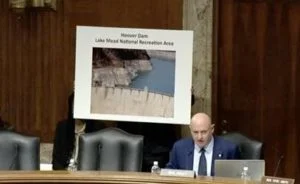WATCH: Sen. Kelly Chairs Bipartisan U.S. Senate Hearing on Western Drought
Hearing outlined the drought’s impact on Arizona, solutions moving forward and how the bipartisan infrastructure bill will enhance drought resiliency in Arizona
Today, Arizona Senator Mark Kelly chaired a hearing of the Senate Subcommittee on Water and Power to examine the historic drought affecting Arizona and the western United States. The hearing covered the impact of climate change on the Colorado River system, Arizona farmers, and hydropower generation. The panel also discussed how the bipartisan infrastructure bill can enhance drought resiliency in Arizona as the state faces water curtailments beginning next year.
Sen. Kelly chairing the Subcommittee on Water and Power on October 6.
In the Senate, Kelly has maintained a focus on combating western drought and water issues. Kelly requested this hearing on western drought after the U.S. Bureau of Reclamation issued new water level projections for Lake Mead and Lake Powell that triggered the first-ever drought restrictions on the Colorado River. Kelly was one of the 22 members of the Senate bipartisan group that reached a $1.2 trillion infrastructure agreement, now called the Infrastructure Investment and Jobs Act, that passed the Senate in August. Kelly played a leadership role in drafting the western water and drinking water portions of the legislation.
The hearing’s witnesses included Tanya Trujillo, Assistant Secretary for Water and Science, U.S. Department of the Interior; Tom Buschatzke, Director, Arizona Department of Water Resources; Julie Schaff Ellingson, Executive Vice President, North Dakota Stockmen’s Association; and Jennifer Pitt, Colorado River Program Director, National Audubon Society.
See highlights from today’s hearing below. Watch the full hearing HERE.
On the Urgency of Tackling Western Drought
Kelly [23:39]: Reclamation predicts there’s a chance next year that water levels in Lake Powell might dip low enough that power generation at Glen Canyon Dam could be affected. And, in some cases, affected significantly. Many other watersheds across the West are facing similar water scarcity and sustainability challenges.
These challenges may sound serious because they are serious. But here’s the thing – there is no country in the world, no country in the world, that is better at solving big problems when we put our minds to it. We can solve this. […]
On How the Bipartisan Infrastructure Bill’s Investments Help Ranchers
Pitt [1:07:36]: I think there are a lot of win-wins with ranchers who are taking good care of the land with additional federal support for infrastructure can also help improve the ecosystem and ecosystem services that we need to scale up right now in order to improve the health of these watersheds that really are the source of our water supply all the way down the river.
On How the Bipartisan Infrastructure Bill Supports Yuma, Lake Mead and Lake Powell
Kelly [54:35]: Can you give a specific example of an infrastructure project that could improve the situation in Lake Mead and Lake Powell?
Trujillo [54:42]: Absolutely. One of them is connected with our binational process and development of additional capabilities of the 242 well field in Arizona. And will help make the system more efficient and allow us to retain more of the surface water storage that’s available. That’s a good example of that capability.
Kelly [55:10]: And by capturing water in other places we can keep more in Lake Mead and Lake Powell?
Trujillo [55:17]: Absolutely. And the expanded authorities in the water recycling category as well will do exactly the same thing.
Kelly [55:27]: Mr. Buschatzke, same question for you, how will this [bipartisan infrastructure bill] funding — can you think of some examples of how this is going to help Arizona and the West?
Buschatzke [55:34]: Yes, Chairman, Kelly. In Yuma, Arizona — the area that Jennifer Pitt referred to in her remarks about lettuce in the winter time — there’s infrastructure improvements that can make sure that over deliveries in the lower part of the [Colorado] River do not occur. That water will not go to waste if those infrastructure improvements are made.
We also are looking, again, at paying for conservation with willing partners and I think some of the funding could be available for that. It is not necessarily infrastructure, but it will result in more water in Lake Mead, and leveraging money that the state has made available to [Arizona Department of Water Resources] for that purpose within our state.
We are working with the Southern Nevada Water Authority, the Metropolitan Water District of Southern California, and the Central Arizona Project on a potential recycling project in Southern California that would allow that recycled water to be used for California instead of being discharged into the ocean, in a way that the other partners could share in some of the benefits of that water in their states. So those are just a couple of examples infrastructure funding, and the funding available in that bill, are critical. We are looking at instate groundwater desalination, looking at doing ocean desalination in the Sea of Cortez with Mexico under Minute 323, so there’s no end to the list of potential projects that can benefit Arizona, the Lower Basin, and Lake Mead.

